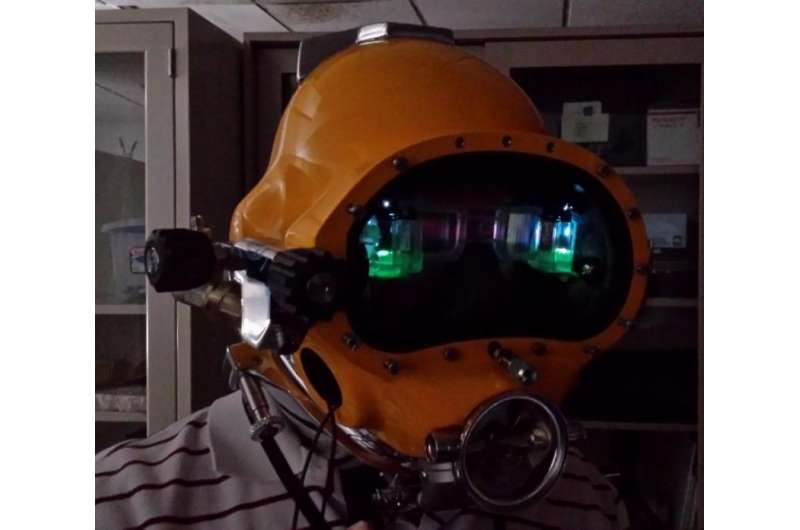Navy engineers develop futuristic next generation HUD for diving helmets

Summer 2016 is heating up with new and upcoming advances in Navy diving technologies at the Naval Surface Warfare Center Panama City Division (NSWC PCD).
Underwater Systems Development Project Engineer Dennis Gallagher and his team are developing what can be described as a "next-generation" and "futuristic" system for the Navy diving community.
The Divers Augmented Vision Display (DAVD) is a high-resolution, see-through head-up display (HUD) embedded directly inside of a diving helmet.
This unique system enables divers to have real-time visual display of everything from sector sonar (real-time topside view of the diver's location and dive site), text messages, diagrams, photographs and even augmented reality videos. Having real-time operational data enables them to be more effective and safe in their missions—providing expanded situational awareness and increased accuracy in navigating to a target such as a ship, downed aircraft, or other objects of interest.
Instead of having to rely on pre-dive briefings alone to determine what they are looking for, how specific items should appear and where they may be located, the DAVD system places the information right before divers' eyes with a look and feel comparable to a point-of-view video game display.
Divers have the ability to turn the HUD on and off, and direct topside to reposition display data in different locations on the HUD.
"By building this HUD directly inside the dive helmet instead of attaching a display on the outside, it can provide a capability similar to something from an 'Ironman' movie," Gallagher commented. "You have everything you visually need right there within the helmet."
The DAVD HUD system can be used for various diving missions, including ship husbandry, underwater construction, and salvage operations. The same system can eventually be used by first responders and the commercial diving community.
As part of its Strategic Plan for 2011-2025 to identify, exploit, and develop technology to advance the state-of-the-art in diving equipment, Naval Sea Systems Command (00C3) is in the process of developing enhanced sensors—such as miniaturized high resolution sonar and enhanced underwater video systems—to enable divers to 'see' in higher resolution up close, even when water visibility is near zero. These enhanced underwater vision systems would be fed directly into the DAVD HUD.
"We constantly engage with the operators; if there is a vision they have, we can make it happen," Gallagher said. "By having this type of positive on-the-spot feedback, you know you're going down the right road."
Gallagher and his team have collaborated with, and demonstrated the system to more than 20 divers from various commands who shared his vision of this futuristic capability for Navy divers.
The team is now working on phase two, where components are being designed to include both helmet systems and full face masks. Divers are scheduled to conduct in-water simulation testing in October. Phase three is set to begin in fiscal year 2017 to harden the system for expanded field testing with various dive commands.
More information: For more information, visit www.navy.mil/, www.facebook.com/usnavy/, or www.twitter.com/usnavy/
Provided by U.S. Navy



















